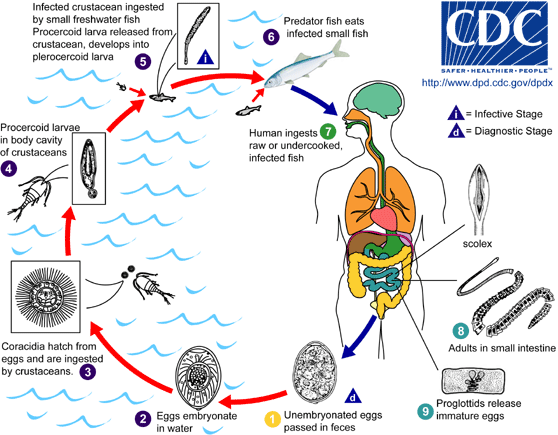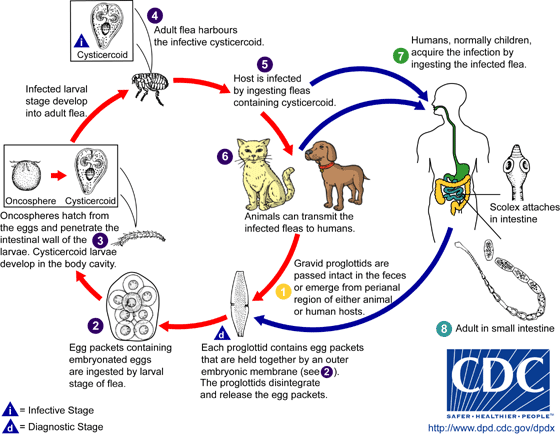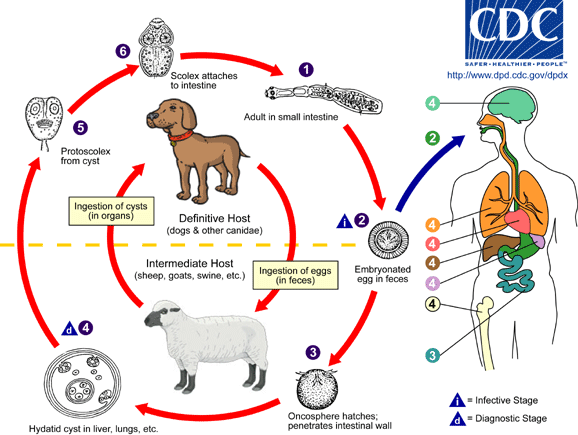Some Tapeworm Species and their Associated Diseases:
Tapeworms (Taenea spp.) Infection with a tapeworm is called Taeniasis, but each species of tapeworm (and there are many not listed here) create their own disease. I’ve listed these diseases under each type of tapeworm discussed where pertinent.
Tapeworms are flat like a ribbon, and made up of segments called proglottids. The proglottids contain between 50 to 60,000 eggs. As the tapeworm grows, the proglottids eventually break off and exit via the anus. Tapeworms live in the small intestine and they anchor into the intestinal wall by means of a scolex (head with several hooks, allowing it to adhere to the intestinal wall. The eggs, which can be seen in the fecal floatation under a microscope, are spherical, measure from 30-45 um, and contain in their interiors the oncosphere. These eggs are very resistant to environmental conditions and can remain infectious for long periods of time. These off-white segments look like rice (until they move!) or can as small as a sesame seed after they have dried up.
Common Sources of Infection— Prevention of tapeworms in people would include eliminating any fleas on the pet and in the environment, not allowing pets to consume rodents and other intermediate hosts, practicing good personal hygiene, preventing fecal contamination of food and water, and not eating uncooked or undercooked meat/fish. What? You say you don’t eat raw meat? Ever use a cold steak as a compress? Well, you can get parasites in your eyes and under your skin if that meat is infected.
It takes an intermediate host for the parasite to develop into a mature worm because it needs special nutrients in one animal that it can’t get in the last animal it matures in. Intermediate hosts can include fish, amphibians, reptiles, birds, mammals of all kinds, family pets, and rodents. Insects such as ants, beetles, cockroaches, flies and fleas when ingested can also give us tapeworms. Children are susceptible to worms because they put so many things into their mouths. I can’t imagine how many people get infested with all kinds of worms eating what they do on those reality shows!
Symptoms of Taeniasis: Diarrhea, anorexia, nausea, vomiting, anal itching, colic, ascites, headaches and weight loss are common symptoms of having tapeworms. With severe infections hives, fever and convulsions can also occur. Sometimes they embed in the tissues causing intestinal nodules or cysts in the skin, lung or liver. An animal or human with a tapeworm may also have a craving for salt. The tapeworms also compete with the organism for Vitamin B 12, so slight anemia can occur. Seen under a microscope, the red blood cells are immature looking and darker in color than mature red blood cells.
Tapeworms are diagnosed by seeing the fresh or dehydrated segments around the anus or on the hair or underwear or by seeing the eggs under a microscope after doing a fecal floatation. The proglottids are motile when freshly passed and may be mistaken for maggots or fly larvae. Please note that if there are only a few tapeworms, they will nest in the small intestine and the doctor may not see the eggs under the scope. It’s also difficult to convince the doctor to do a fecal exam sometimes (in the human medicine world, not the animal medicine world.)
Treatment for Tapeworms: Praziquantel, Epsiquantel (Cestex), Niclosamide, Quinacrine
Tapeworm—Diphyllobothrium latum, causes diphyllobothriasis and is transferred from raw fish to humans and dogs. Pike, salmon, trout and perch are the major source for humans, so be sure to examine your lox before you put it onto your bagel and you might want to ask what kind of fish are in your sushi! Actually, most any animal eating raw fish can also get this particular tapeworm. The arrows in the pictures below point to the cap (operculum) where all the immature parasites hatch from when they are old enough.
Reference: https://www.dpd.cdc.gov/dpdx/HTML/Diphyllobothriasis.htm
Tapeworm—Dipylidium caninum: Dipylidium caninum worms are passed by eating fleas. Dogs and cats can also get tapeworms from eating mice. This worm infects dogs, cats, foxes, coyotes and man. Here is what you will see when you do a fecal flotation and look at the sample under microscopic low-power magnification:
Reference:
- Lifecycle of Dipylidium caninum: https://www.dpd.cdc.gov/dpdx/HTML/Dipylidium.htm
Tapeworm–Echinococcus, the sheep tapeworm causes echinococcus or hydatidosis. This one is really bad as it gets into the brain and grows. If the surgeon accidentally pops the sac containing the eggs, you can count on purchasing a cemetery plot. Symptoms of Echinococcosis/Hydatidosis include an enlarged liver, ascites, swollen abdomen and dull abdominal pain. Possible anaphylaxis can happen if the cysts are ruptured. Diagnosis: Often these are discovered only upon necropsy. Radiographs, ultrasounds, and serological testing of the blood can help rule in or out the diagnosis of Echinococcosis although if the cysts have never ruptured the tests could be falsely negative. You actually have to take an aspirate of the cyst to see the eggs in that fluid, but when you do this, you run the risk of spreading the parasite throughout the body.
The cycle involves rodents or grass-eating animals (called ungulates) such as cattle, sheep, deer, elk and other animals with four stomachs. They eat the grass contaminated with infected dog poop and the worms mature. If we eat the meat that has the worms, they can form cysts in our lungs, liver and inside our brain. So, worm your animals a couple times a year if they are out-of-doors and get into carcasses or catch game of any kind. This will help cut down on the spread of this disease.
Reference: https://www.dpd.cdc.gov/dpdx/HTML/ImageLibrary/Echinococcosis_il.htm
Tapeworms—Hymenolepis nana and Hymenolepis diminuta cause hymenolepiasis and are transmitted through rat poop: There are several tapeworms that are passed through rodent feces. Hymenolepis nana and H. Diminuta are passed to humans if a human eats flour infested with beetles that have eaten rat poop. In addition to normal tapeworm symptoms, nervous system disturbances such as increased restlessness and convulsions can occur. So, don’t eat food contaminated with rodent feces or beetles. In this fecal floatation you can see the egg with the little scolex (head with horn-like things that later bite into and attach to the inside of the small intestine) in the center of the egg.
Tapeworm—Sparganosis comes from water infected with Cyclops protozoa. The plants growing in this water (like watercress) get infected with the stage of development passed on to humans when they eat the plant.
Tapeworm—Taenia pisiformis: Can infect dogs, cats, foxes, bobcats, coyotes, and wolves, and are passed to the cat from eating dog or cat fleas and rodents.
Tapeworm—Taenea saginata: The beef tapeworm Taenea saginata can be up to 12 feet in length (see picture on the right) once it reaches adult stage. A picture of an egg from a fecal floatation is on the left. Here’s how this works: A cow or pig eats vegetation infected with the egg or proglottids (a piece of the tapeworm). One of the immature stages of the tapeworm embeds and migrates through the tissues of the animal. A human comes along and eats the undercooked or raw meat and the immature parasite matures in the intestinal tract of the human.
One gross fun fact for you. A couple decades ago they used tapeworms as a dietary aid. The person wanting to lose weight ate the tapeworm segments after they were put into a gelatin capsule. When they lost the weight they wanted to (the worms do use up a lot of nutrition) then the person would worm themselves and see the worms pass in the toilet. Gross, eh?
Reference: https://www.dpd.cdc.gov/dpdx/HTML/ImageLibrary/Taeniasis_il.htm
Tapeworm—Taenia solium, the pork tapeworm, is from one to several meters in length and is able to produce two diseases in the human, the taeniosis and cysticercosis. The taeniosis (intestinal form) is an exclusive disease of humans, often asymptomatic, and can perhaps maintain the infection for years. The main clinical manifestation is the frequent spontaneous elimination of proglottids in the feces. Approximately 5% to 40% of people with taeniosis develop into cysticercosis, confirming the fecal-oral contamination and infections of people associated with them. The neuro-cysticercosis in the human occurs when the infected cysticerci preferably infect the central nervous system, with epilepsy being one of the most frequent symptoms. This is the most dangerous and characteristic outcome of the neural form of this disease, affecting thousands of people in developing countries of South and Central America, Africa and Asia; nevertheless, in developed countries the disease is also present, most often in immigrants, travelers and tourists returning from endemic zones. See Taenia saginata above for pictures. They look almost identical.






